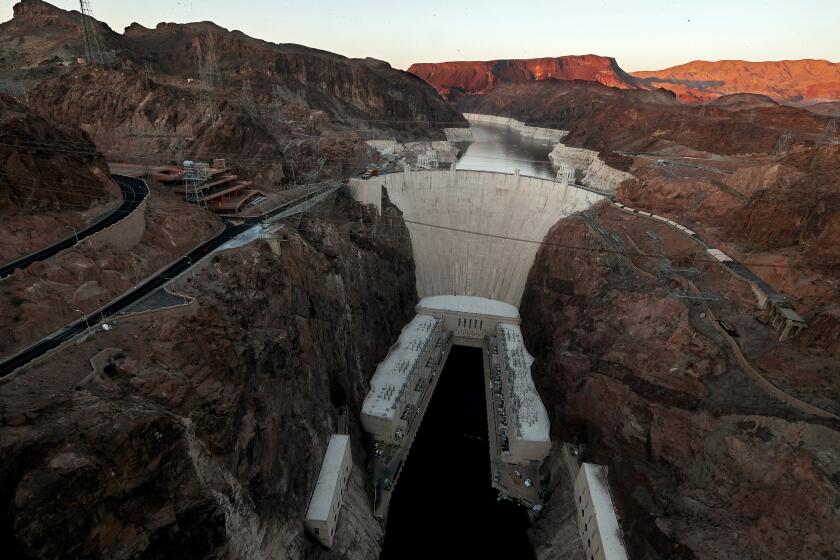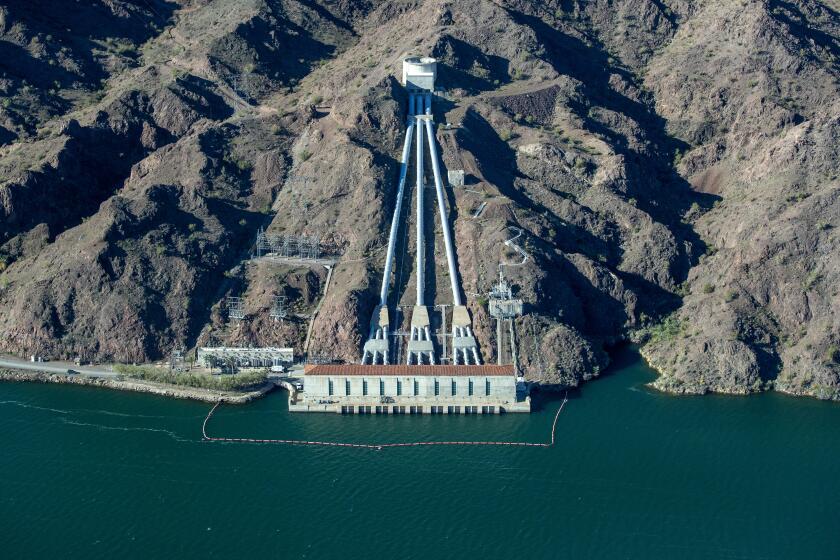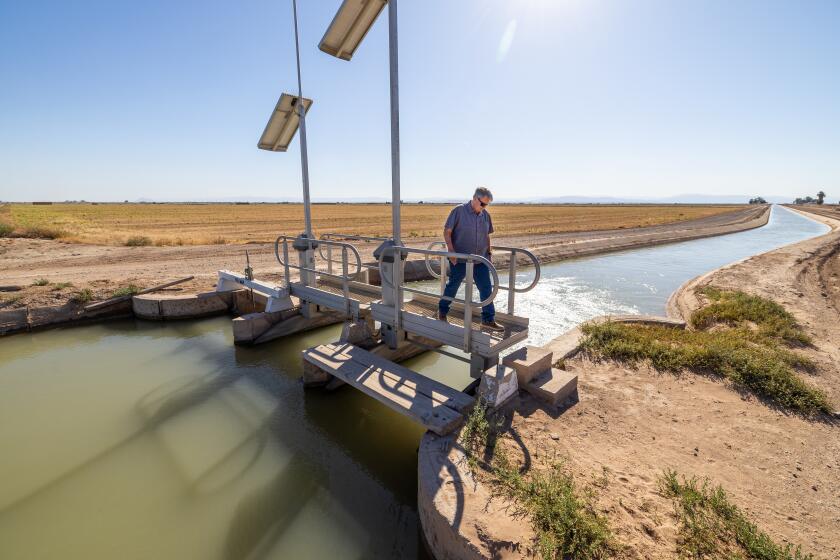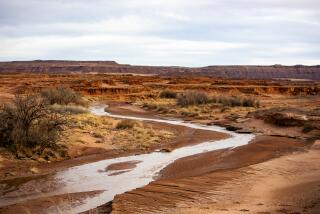
- Share via
Seven Western states that depend on the Colorado River are ending the year at an impasse in negotiations over the writing of new rules for dealing with chronic water shortages.
Representatives of California and other states who attended an annual Colorado River conference in Las Vegas last week said they remain deadlocked in their talks on long-term plans for reducing water use to prevent the river’s reservoirs from reaching critically low levels.
Disagreements over competing proposals have created a deep rift between two camps: the three states in the river’s lower basin — California, Arizona and Nevada — and the four states in the river’s upper basin — Colorado, Utah, Wyoming and New Mexico.
Those on both sides say they are willing to continue trying to reach a deal on how to apportion cutbacks in water use after 2026, when the current rules expire. But they also say easing the stalemate will be difficult.
Negotiations over the last year have brought “zero progress,” said JB Hamby, California’s Colorado River commissioner. He blamed the upper basin states for an entrenched position resisting participation in the cutbacks, which he said is untenable.
It’s worrying that there is a “widening chasm” between the sides, Hamby said. “We are running out of time, and we’re no closer to much of anything at this point than at the beginning.”
Federal officials release a proposal outlining options for new, long-term rules for managing chronic water shortages from the overtapped Colorado River.
The Biden administration last month outlined a range of alternatives for the new guidelines, which will replace interim rules that were adopted in 2007. Along with that ongoing federal review process, President-elect Donald Trump’s administration is set to inherit a role in searching for a plan that all seven states can accept.
The impasse has raised the possibility that if disagreements aren’t resolved, the states could enter a legal battle, a path riddled with uncertainty that water managers in both camps have said they hope to avoid.
The tensions were apparent during last week’s Colorado River Water Users Assn. conference in Las Vegas, an event that often features negotiating sessions in addition to speeches outlining proposals for reducing demands on the river.
One public disagreement emerged over the lack of a meeting of the seven states’ representatives at the conference, a closed-door discussion that was usually scheduled in previous years.
Becky Mitchell, Colorado’s top negotiator, said during one public session that she had expected representatives of all seven states to meet before the gathering started, but “that did not occur.”
Hamby took issue with her comment in an interview after the conference, saying it was untrue to suggest the lower basin states had denied a request to meet. Hamby said Mitchell had emailed him and others Dec. 2 to ask if they would have time to meet on Dec. 3 before the start of the conference, but he told her that wouldn’t work because his flight was scheduled to arrive later.
Hamby accused Mitchell of trying to portray representatives of California, Arizona and Nevada as being unwilling to talk.
“It was a last-minute pointed request meant to not generate a meeting, and then use it as a media sound bite,” Hamby said. “It begs the question, why would we want to talk to them when this is the sort of childish antics that seem to be increasingly dominating the upper basin’s manner of behavior? Not focused on actual issues, but how do we play gotcha games in the media that misrepresent each other.”
Mitchell denied that, saying she emailed hoping all the states’ representatives would meet during the week, but that didn’t happen.
“My intention is to find a way to move forward,” she said. “And so I’d be willing to meet any time — Zoom, phone, in person, anywhere.”
Two groups of states in the Colorado River Basin propose competing long-term plans for addressing chronic water shortages and adapting to climate change.
The Colorado River provides water for cities from Denver to Los Angeles, 30 Native tribes and farmlands from the Rocky Mountains to northern Mexico.
The river has long been over-allocated, and its reservoirs have declined dramatically since 2000. The average flow of the river has shrunk about 20% since 2000, and scientists have estimated that roughly half that decline has been caused by global warming driven by the burning of fossil fuels and rising levels of greenhouse gases.
The decline in flow is projected to worsen as temperatures rise.
In recent years, the states have adopted a series of incremental water-saving plans to try to prevent reservoirs from reaching perilously low levels.
California water agencies say they have reduced water use by more than 1.2 million acre-feet over the last two years, decreasing the state’s usage of Colorado River supplies to the lowest levels since the 1940s. Some of those water savings have come through the Biden administration’s funding of programs that pay farmers to temporarily leave fields dry to reduce water use.
Those efforts have helped conserve water in Lake Mead, the country’s largest reservoir. As of this week, the reservoir near Las Vegas is 33% full.
Upstream on the Utah-Arizona border, the water level of Lake Powell, the nation’s second-largest reservoir, stands at 38% of capacity.
With the negotiations on future water reductions at an impasse, some experts at the conference discussed the possibility of a legal fight being decided by the U.S. Supreme Court.
Summarizing the mood at the meeting in an article for the news site Aspen Journalism, reporter Heather Sackett wrote that “speakers invoked Dr. Strangelove, the Hunger Games and Alice in Wonderland to convey the dire, darkly dystopian and illusory state of the negotiations.”
Mitchell told The Times in an interview that the hard discussions reflect the difficulty of making substantial changes to adapt when the reservoirs are at low levels.
Imperial Valley farmers left fields dry temporarily to help ease the Colorado River’s shortage. The program has led to concerns about the shrinking Salton Sea.
“When you’re negotiating at or near crisis points within these reservoirs, it becomes more and more difficult,” Mitchell said.
Still, Mitchell said she is hopeful the negotiators will be able to progress in the talks.
“I really feel like we might want to spend some time looking at where we have some common ground, and see what we can build on from there,” Mitchell said. “We have to look at what the supply is and share that.”
The two groups of states have presented starkly different proposals, disagreeing on how triggers for mandatory cutbacks should be determined, and how the reductions should be apportioned.
Representatives of California, Arizona and Nevada say the upper states’ proposal is unworkable because it would require the lower states to shoulder the burden of the cuts, while the lower basin’s proposal would spread the cuts throughout the region when reservoirs reach low levels.
Representatives of Colorado, Utah, Wyoming and New Mexico say they are seeking proportionate reductions. Officials from those states have said because water users in their region largely depend on snowmelt rather than water releases from reservoirs, they already regularly face serious shortages.
Water managers in the upper basin states have come under criticism recently from environmentalists and officials in other states for moving ahead with plans for new dams and diversions that would take more water from the river.
Hamby said those plans are a source of concern.
“This is not the time for putting a further strain on an already stressed river that’s only going to be getting smaller in the future,” Hamby said.
Mitchell said agencies in Colorado are developing such projects with the understanding that their water rights will likely be curtailed in many years because of limited supplies.
“In many cases, new storage projects will essentially simply help folks store water in wet years so they can survive in the dry years,” she said. “We need to take advantage of those.”
The river continues to be managed under a legal framework based on the 1922 Colorado River Compact, which allocated the water among the states.
The 1922 agreement requires the four states of the upper basin to deliver an annual average of 7.5 million acre-feet to California, Arizona and Nevada over any 10-year period.
New research shows global warming has become the dominant driver of worsening drought in the western United States.
Arizona officials have warned that projections show water deliveries might decrease below that required minimum in the coming years, which would enable the lower basin states to make a so-called “compact call” and require the upper basin states to meet the requirement by cutting their water usage.
Tom Buschatzke, director of the Arizona Department of Water Resources, requested $1 million from state leaders this year to prepare for the potential costs of going to court if the states fail to reach an agreement.
“We’d rather find a negotiated way,” Buschatzke said. “But the challenge for all seven of us is to create an outcome in which we do not back each other into a corner.”
John Entsminger, Nevada’s representative and general manager of the Southern Nevada Water Authority, said despite the tensions, the situation is not hopeless. He said he has continued having productive discussions one on one with officials from other states.
Early next year, Entsminger said, “the states need to get back to work and start forging a solution.”











